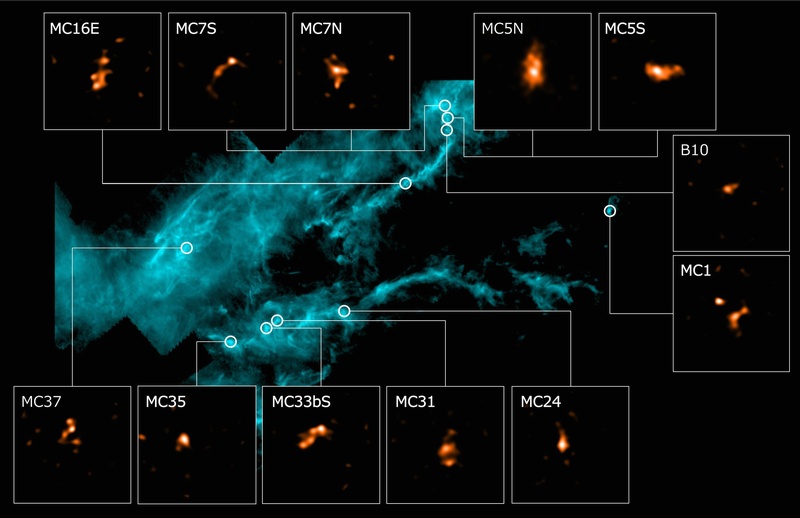They also found a bipolar outflow, a pair of gas streams - that could be telltale evidence of a truly newborn star.
Stars are formed by gravitational contraction of gaseous clouds. The densest parts of the clouds, molecular cloud cores, are the very sites of star formation and mainly located along the Milky Way. The Taurus Molecular Cloud is one of the active star-forming regions and many telescopes have been pointed at the cloud. Previous observations show that some cores are actually stellar eggs before the birth of stars, but others already have infant stars inside.

Wide-field far-infrared image of the Taurus Molecular Cloud obtained by the Herschel Space Observatory and stellar eggs observed with ALMA (insets). (Credit: ALMA (ESO/NAOJ/NRAO), Tokuda et al., ESA/Herschel)
The research team observed 32 starless cores and nine cores with baby protostars. They detected radio waves from all of the nine cores with stars, but only 12 out of 32 starless cores showed a signal. The team concluded that these 12 eggs have developed internal structures, which shows they are more evolved than the 20 quite cores.
Radio interferometers using many antennas, like ALMA, are not well suited for observing featureless objects like stellar eggs so the team only used the 7-m antennas. The compact array enabled them to see objects with smooth structure, and also yielded information about the internal structure of the stellar eggs.
Increasing the spacing between the antennas improves the resolution of a radio interferometer, but makes it difficult to detect extended objects. A compact array has lower resolution but allows us to see extended objects. This is why the team used ALMA’s compact array of 7-m antennas, as known as the Morita Array, not the extended array of 12-m antennas.
They found that there is a difference between the two groups in the gas density at the center of the dense cores. Once the density of the center of a dense core exceeds a certain threshold, about one million hydrogen molecules per cubic centimeter, self-gravity leads the egg to transform into a star.
A census is also useful for finding a rare object. The team noticed that there is a weak but clear bipolar gas stream in one stellar egg. The size of the stream is rather small, and no infrared source has been identified in the dense core. These characteristics match well with the theoretical predictions of a “first hydrostatic core,” a short-lived object formed just before the birth of a baby star.
“Several candidates for the first hydrostatic cores have been identified in other regions,” explains Kakeru Fujishiro, a member of the research team. “This is the first identification in the Taurus region. It is a good target for future extensive observation.”
References:
K. Tokuda et al. “Fragmentation and Evolution of Dense Cores Judged by ALMA (FREJA). I (Overview). Inner ~1,000 au Structures of Prestellar/Protostellar Cores in Taurus,” The Astrophysical Journal. https://doi.org/10.3847/1538-4357/ab9ca7
K. Fujishiro et al. “A Low-velocity Bipolar Outflow from a Deeply Embedded Object in Taurus Revealed by the Atacama Compact Array,” The Astrophysical Journal Letters Aug. 7, 2020.






Comments